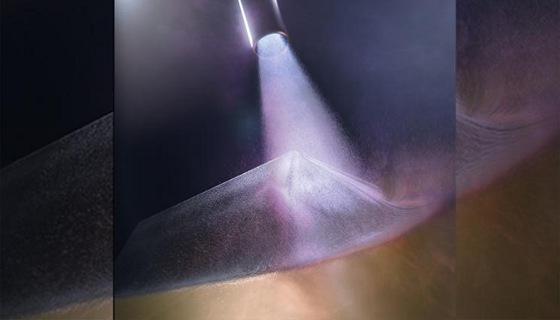 |
| November 03, 2020 | Volume 16 Issue 42 |
Designfax weekly eMagazine
Archives
Partners
Manufacturing Center
Product Spotlight
Modern Applications News
Metalworking Ideas For
Today's Job Shops
Tooling and Production
Strategies for large
metalworking plants
Cold spray tech wins R&D 100 award -- could help turn pipes into thermoelectric generators

In a cold spray chamber, particles of the brittle thermoelectric material bismuth telluride are accelerated to more than 900 m/sec, or almost Mach 3, in inert gas and directed onto a copper surface, laying down the strips that form the basis of a functioning thermoelectric generator to harvest waste heat. [Graphic by Jacob Long/LLNL]
Lawrence Livermore National Laboratory (LLNL) researchers are among the developers of the top 100 industrial inventions worldwide, winning an R&D 100 award at this year's annual event.
The trade journal R&D World Magazine announced the winners of the awards, sometimes called the "Oscars of invention," during three separate virtual events on Sept. 29 and 30 and Oct. 1.
With this year's results, LLNL has now captured a total of 170 R&D 100 awards since 1978.
This year's LLNL award is for a new technique called Versatile Cold Spray (VCS) that has been developed through a partnership of the lab and TTEC Thermoelectric Technologies, a Berryville, VA-based company.
"This recognition in the R&D 100 competition is a tribute to the innovative spirit of our scientists and engineers," said Lab Director Bill Goldstein. "Teaming with industrial collaborators is an important element in ensuring that technologies developed here will benefit the nation."
The new VCS technique deposits a broad range of brittle and glassy materials, including functional materials such as thermoelectric devices and magnets, onto any substrate. Traditionally, cold spray technology uses metals to build up layers for applications like metal part repair.
VIDEO: Versatile Cold Spray (VCS) enables deposition of brittle materials, such as thermoelectrics, magnets, and insulators, while retaining their functional properties. Materials can be deposited on substrates or arbitrary shapes with no requirement to match compositions. The VCS system is low cost, easily portable, and easy to use. [Video credit: LLNL]
Unlike most competitive additive manufacturing techniques, the VCS preserves the crystal microstructure of brittle materials, so materials applied with this technology retain their functional properties.
This capability, combined with the VCS unique equipment design, opens the door to creating thermoelectric generators and other functional components such as permanent magnets and insulators on industrial parts with complex shapes.
Thermoelectric generators are solid-state devices that convert temperature differences directly into electrical energy. Their applications for harvesting waste heat have been limited by fabrication and materials challenges.
Applying thermoelectric material coatings to heat-emitting surfaces, such as cooling fins and transfer pipes in industrial facilities, could transform industrial components into thermoelectric generators. These thermoelectric generators offer an elegant and efficient energy-harvesting option, as they have no moving parts and do not rely on potentially toxic or flammable chemical reactions.
Waste heat is an immense untapped resource. Thirteen quadrillion British Thermal Units (or BTUs) of energy are lost annually through waste heat by industrial operations in the United States. A BTU is a unit of measurement for energy; 3,600 BTU is equivalent to about 1 kilowatt hour.
If only half of the U.S. industrial waste heat were converted into electricity, it would meet the country's total energy needs for nearly a month.
In a journal article earlier this year, the Livermore team reported cold spraying a bismuth-telluride powder on substrates ranging from stainless steel to aluminum silicate and quartz. The sprayed material had a randomly oriented microstructure largely free from pores, and the cold-spray deposition was achieved without substantial compositional changes.
The portable design of the VCS technology enables the application of coatings on equipment already installed in industrial facilities, transforming fixed pieces of existing equipment into functional devices, depending on the coating selected. Other key parts of the technology are the nozzle design and the process, both of which are patented.
The team is working to expand the range of materials that can be deposited with the VCS. It is open to collaborations that seek to leverage this unique technique.
The LLNL VCS research team is led by physicist Harry Radousky and includes physicists Elis Stavrou and Nathan Woollett, and materials physicists Scott McCall and Alex Baker. Other award winners of the collaboration include Annemarie Meike, a business development executive in the Lab's Innovation and Partnerships Office, and TTEC President Richard Thuss.
Source: LLNL
Published November 2020
Rate this article
View our terms of use and privacy policy
